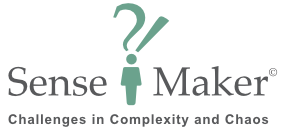Free material
Feel free to be inspired or to download some of the material, Sandra Greve has developed. The material is free of charge, as long as you clearly refer to SenseMaker ApS
Six focus areas when managing knowledge
What is facilitation and why is it important?
Appreciative Inquiry and coaching as facilitation tools
Executive MBA thesis from Henley Business School
Towards an understanding of how to enhance sensemaking in organizational strategic change
by Sandra Greve, supervisor George Tovstiga
Management_Challenge_Sandra_Greve_82107332_without_appendices
Executive summary
This Management Challenge (MC) arises from the one-man consultancy SenseMaker ApS owned by the author of the MC. Daily, the author see SenseMaker customers struggle to succeed with strategic change in a turbulent context. This fact combined with the author´s strong interest in sensemaking led to the purpose of this MC to generate new insights around the notion of sensemaking that might then find use in organisations engaging in strategic change by investigating:
- What is the role of sensemaking in organizational strategic change?
- What is the current state of sensemaking in organizational strategic change?
- Which factors might enhance the effectiveness of sensemaking in organizational strategic change?
- What are the limitations to sensemaking in organisational strategic change?
The investigation is based on a Delphi study with five panels: employees, CEO´s, consultants, academics and medical doctors. The panels were gathered in physically unstructured dialogue sessions to explore the research questions from the perspectives of the traditional practice field engaging in organizational strategic change – and by high reliability organizations (HROs) which by Weick and Sutcliffe (2007) are defined as organizations who have developed more mindful practices that make them perform better than most traditional practices in a turbulent context.
Findings show that to avoid inertia and sensemaking blockages, continuous changes are preferred because of a general increase in complexity in business environments.
The role of sensemaking in organizational strategic change is considered necessary to generate change – especially within a strategic context, because it often demands that the ideas of top management have to make sense to the rest of the organization.
The current state of sensemaking in organizational strategic change within the traditional practice field shows that the concept of strategy is drifting towards a more tactical and operational nature – and that although there is a high awareness of what to do, action is blocked by the traditional organizational system and structures.
The main factors to enhance sensemaking in organizational strategic change are creating a movement with a higher purpose, within an environment of confidence, sincerity, open dialogue and acceptance of paradoxes and ambiguity. The higher uncertainty and the shorter planning horizon, the more important HRO practices becomes, e.g. improvisation and calm overview within clear structure, roles, prioritization and help mobilized within the system.
The limitations to sensemaking in organisational strategic change are strong sensemaking blockages within the traditional practice field, showing a circular intent but with linear output and a strong need for labelling and placing responsibility.
Recommendations for the professional sensemaker, i.e. the CEO, manager and consultant engaging in organizational strategic change, is listed by following the three sequence model of Weick and Quinn (1999) for continuous change.
Implications with respect to new insights into sensemaking in the context of organizational strategic change are derived from two different levels – the individual, e.g. the professional sensemaker and the collective, i.e. the organization.

